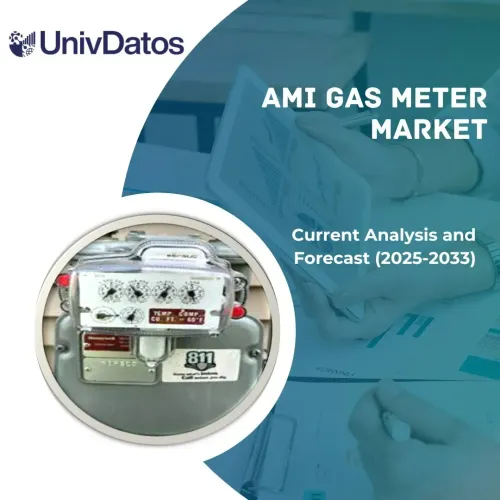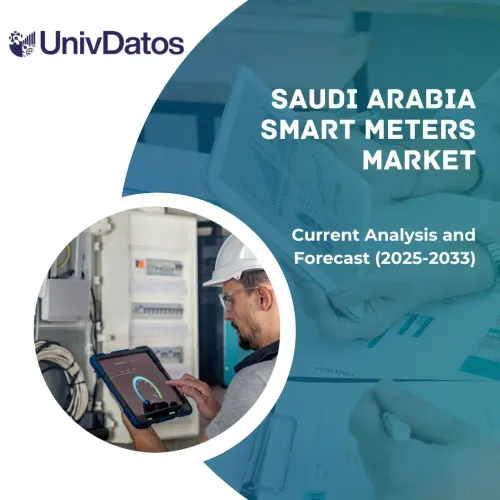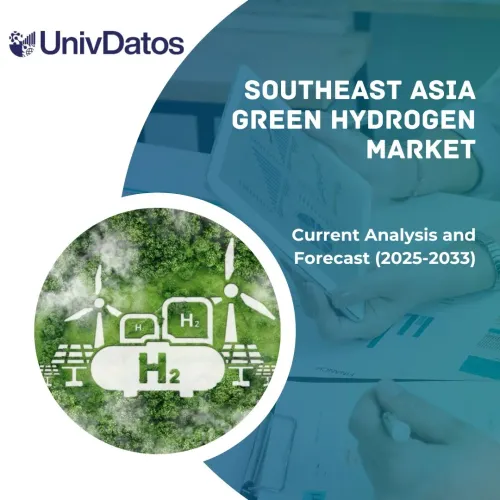- Home
- About Us
- Industry
- Services
- Reading
- Contact Us
Solar Water Purifiers Market: Current Analysis and Forecast (2022-2030)
Emphasis on Technology (Solar Water Disinfection (SODIS), Solar Distillation, and Solar Water Pasteurization); Device (Stationary and Portable); End-User (Residential and Commercial); and Region/Country
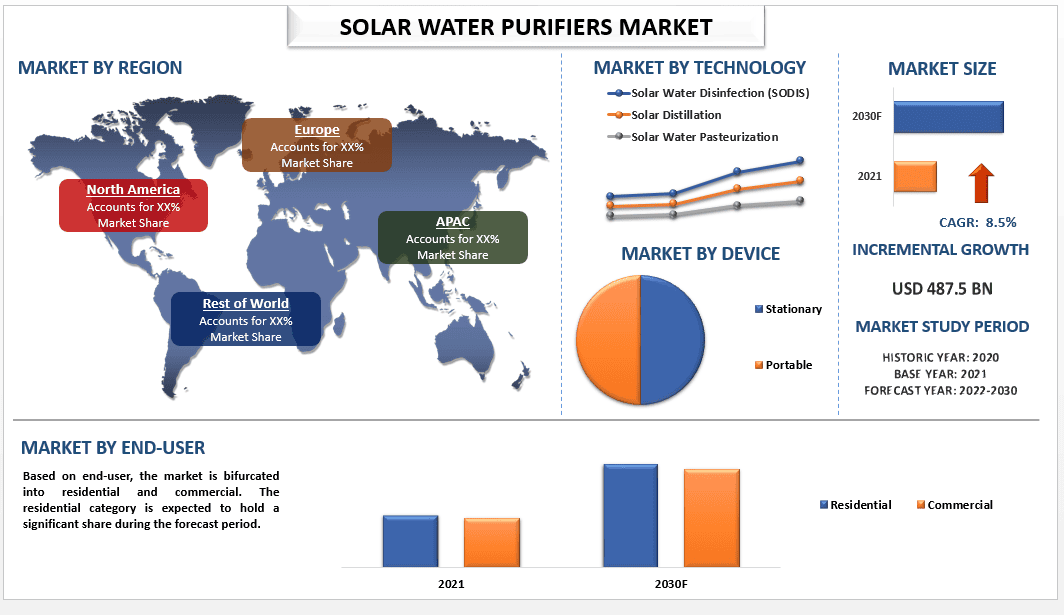
Global Solar Water Purifiers Market is expected to grow at a significant rate of 8.5% during the forecast period. Solar Water Purifiers are described as purified water for drinking and household purposes through the usage of solar energy in many ways. Solar water purifiers use sunshine to convert contaminated water into clean, drinkable water. Solar water purification is considered an effective method of pathogen-contaminant purification. This is due to the proven nature of the technology and the inexpensive ways by which such a solar water purifier can be built. Solar water purifiers are devices that remove harmful bacteria and viruses from the water through solar energy. They use a small solar panel to power a water purification system, allowing them to work even in remote areas where large electric generators are not readily available. Furthermore, the growing adoption of renewable energy along with an increasing number of waterborne diseases is growing the market for solar water purifiers. For instance, in Jan 2023, Researchers in South Korea developed a novel water filter that can remove 99.9 percent of microplastics. This new solar-based water purification system can filter out microplastics quickly.
Nevon Projects; WattSun – Energy India Private Ltd; Tata Power; C AND B International Holdings Co.,LTD; Jakson Group; NETSOL WATER SOLUTIONS PVT. LTD; NEWater; Swajal Water Pvt. Ltd.; GSEL R TECH LTD are some of the key players in the market. Several M&As along with partnerships have been undertaken by these players to facilitate customers with hi-tech and innovative products/technologies.
Insights Presented in the Report
“Amongst technology, solar water disinfection category accounted for a significant market share in 2021”
Based on technology, the solar water purifiers market is segmented into solar water disinfection (SODIS), solar distillation, and solar water pasteurization. The solar water disinfection segment accounted for a significant market share in 2021. This is mainly because this technology is very economical and has less investment cost as it relies on locally available resources, plastic bottles, and sunlight. In addition, the technology is typically carried out in rural communities of developing countries where no centralized water treatment facilities are available.
“Amongst device, portable category is expected to grow with a significant CAGR during the forecast period”
Based on device, the solar water purifiers market is divided into stationary and portable. The portable category is expected to grow with a significant CAGR during the forecast period. This is mainly owing to reasons that they do not use electricity and do not emit any greenhouse gases; portable solar water purifiers are sustainable and friendly to the environment. This makes them an ideal answer for people who need to lessen their carbon impression and safeguard the climate. Additionally, climate change is increasing the severity and frequency of natural disasters like hurricanes, droughts, and floods, which frequently result in contaminated water sources.
Solar water purifiers Market Report Coverage
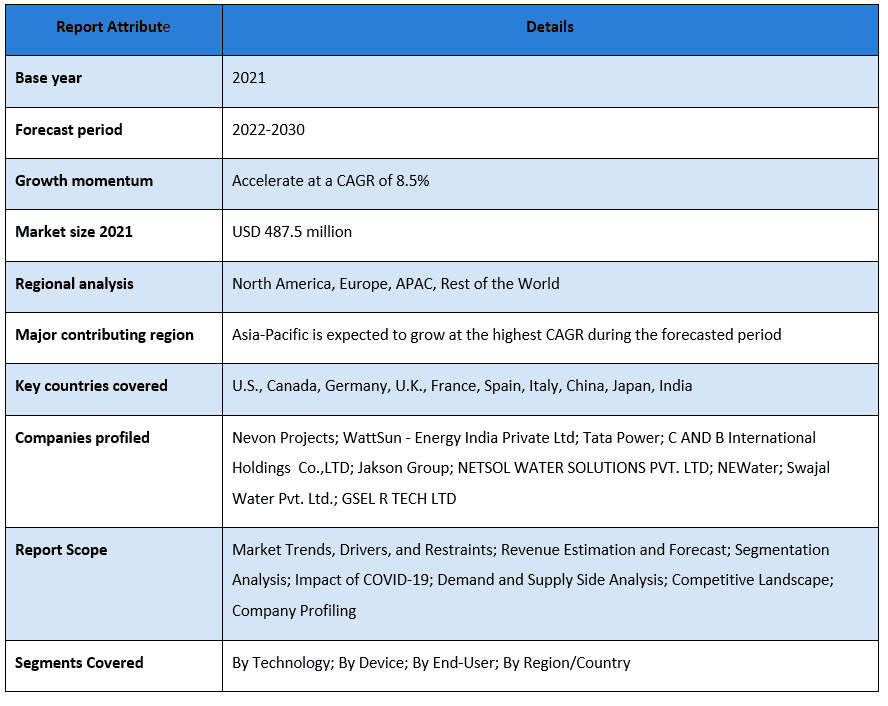
“APAC is dominating the market in the year 2021”
APAC is dominating the market in the year 2021. This is mainly due to factors such as increasing awareness of water scarcity, government initiatives and policies towards using renewable energy, off-grid applications, and technological advancements. The use of solar water purifiers is beneficial in areas where access to clean drinking water is limited or unreliable. The continuous upgradation in solar energy technology such as improvements in solar panels and energy storage solutions. For instance, in Jan 2023, Researchers in South Korea developed a novel water filter that can remove 99.9 percent of microplastics. This new solar-based water purification system can filter out microplastics quickly.
Reasons to buy this report:
- The study includes market sizing and forecasting analysis validated by authenticated key industry experts.
- The report presents a quick review of overall industry performance at one glance.
- The report covers an in-depth analysis of prominent industry peers with a primary focus on key business financials, product portfolios, expansion strategies, and recent developments.
- Detailed examination of drivers, restraints, key trends, and opportunities prevailing in the industry.
- The study comprehensively covers the market across different segments.
- Deep dive regional level analysis of the industry.
Customization Options:
The global solar water purifiers market can further be customized as per the requirement or any other market segment. Besides this, UMI understands that you may have your own business needs, hence feel free to connect with us to get a report that completely suits your requirements.
Table of Content
Research Methodology for the Solar Water Purifiers Market Analysis (2022-2030)
Analyzing the historical market, estimating the current market, and forecasting the future market of the global solar water purifiers market were the three major steps undertaken to create and analyze the adoption of solar water purifiers in major regions globally. Exhaustive secondary research was conducted to collect the historical market numbers and estimate the current market size. Secondly, to validate these insights, numerous findings and assumptions were taken into consideration. Moreover, exhaustive primary interviews were also conducted, with industry experts across the value chain of the global solar water purifiers market. Post assumption and validation of market numbers through primary interviews, we employed a top-down/bottom-up approach to forecasting the complete market size. Thereafter, market breakdown and data triangulation methods were adopted to estimate and analyze the market size of segments and sub-segments of the industry pertains to. Detailed methodology is explained below:
Analysis of Historical Market Size
Step 1: In-Depth Study of Secondary Sources:
Detail secondary study was conducted to obtain the historical market size of the solar water purifiers market through company internal sources such as annual reports & financial statements, performance presentations, press releases, etc., and external sources including journals, news & articles, government publications, competitor publications, sector reports, third-party database, and other credible publications.
Step 2: Market Segmentation:
After obtaining the historical market size of the solar water purifiers market, we conducted a detailed secondary analysis to gather historical market insights and share for different segments & sub-segments for major regions. Major segments are included in the report as technology, device, and end-user. Further country-level analyses were conducted to evaluate the overall adoption of testing models in that region.
Step 3: Factor Analysis:
After acquiring the historical market size of different segments and sub-segments, we conducted a detailed factor analysis to estimate the current market size of the solar water purifiers market. Further, we conducted factor analysis using dependent and independent variables such as various technology, device, and end-user of solar water purifiers. A thorough analysis was conducted for demand and supply-side scenarios considering top partnerships, mergers and acquisitions, business expansion, and product launches in the solar water purifiers market sector across the globe.
Current Market Size Estimate & Forecast
Current Market Sizing: Based on actionable insights from the above 3 steps, we arrived at the current market size, key players in the global solar water purifiers market, and market shares of the segments. All the required percentage shares split, and market breakdowns were determined using the above-mentioned secondary approach and were verified through primary interviews.
Estimation & Forecasting: For market estimation and forecast, weights were assigned to different factors including drivers & trends, restraints, and opportunities available for the stakeholders. After analyzing these factors, relevant forecasting techniques i.e., the top-down/bottom-up approach were applied to arrive at the market forecast for 2030 for different segments and sub-segments across the major markets globally. The research methodology adopted to estimate the market size encompasses:
- The industry’s market size, in terms of revenue (USD) and the adoption rate of the solar water purifiers market across the major markets domestically
- All percentage shares, splits, and breakdowns of market segments and sub-segments
- Key players in the global solar water purifiers market in terms of products offered. Also, the growth strategies adopted by these players to compete in the fast-growing market
Market Size and Share Validation
Primary Research: In-depth interviews were conducted with the Key Opinion Leaders (KOLs) including Top Level Executives (CXO/VPs, Sales Head, Marketing Head, Operational Head, Regional Head, Country Head, etc.) across major regions. Primary research findings were then summarized, and statistical analysis was performed to prove the stated hypothesis. Inputs from primary research were consolidated with secondary findings, hence turning information into actionable insights.
Split of Primary Participants in Different Regions
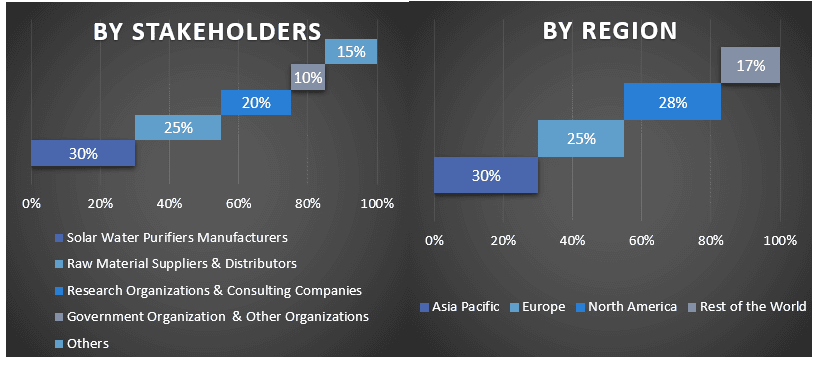
Market Engineering
The data triangulation technique was employed to complete the overall market estimation and to arrive at precise statistical numbers for each segment and sub-segment of the global solar water purifiers market. Data was split into several segments & sub-segments post studying various parameters and trends in the areas of technology, device, and end-user in the global solar water purifiers market.
The main objective of the Global Solar water purifiers Market Study
The current & future market trends of the global solar water purifiers market were pinpointed in the study. Investors can gain strategic insights to base their discretion for investments on the qualitative and quantitative analysis performed in the study. Current and future market trends determined the overall attractiveness of the market at a regional level, providing a platform for the industrial participant to exploit the untapped market to benefit from a first-mover advantage. Other quantitative goals of the studies include:
- Analyze the current and forecast market size of the solar water purifiers market in terms of value (USD). Also, analyze the current and forecast market size of different segments and sub-segments
- Segments in the study include areas of technology, device, and end-user.
- Define and analysis of the regulatory framework for the solar water purifiers
- Analyze the value chain involved with the presence of various intermediaries, along with analyzing customer and competitor behaviors of the industry.
- Analyze the current and forecast market size of the solar water purifiers market for the major region.
- Major countries of regions studied in the report include Asia Pacific, Europe, North America, and the Rest of the World.
- Company profiles of the solar water purifiers market and the growth strategies adopted by the market players to sustain in the fast-growing market
- Deep dive regional level analysis of the industry
Related Reports
Customers who bought this item also bought

